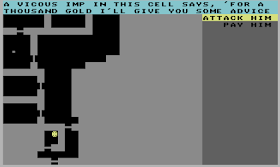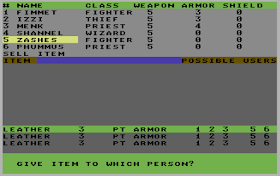 |
| The game comes down firmly on the side of "torture doesn't work." In this case, a tortured guard is giving me directions to a trap rather than the real princess. |
For some reason, I thought that Phantasie II would only take a few hours. I must have been influenced by my Phantasie coverage, in which I won the game in three postings. Sometimes I forget that I summarized and elided a lot during my first 6-8 months of blogging. It's a little painful to read those postings today.
Not that I'm complaining--the game remains fun. It's far less linear than I expected. I thought I remembered Phantasie and Phantasie III ushering you from dungeon to dungeon in a obvious order, discouraging you from getting off the path by generating difficult monster encounters in places you weren't supposed to explore yet. Even if that memory is correct, Phantasie II is the exception. Not only was it unclear where I should go after the first dungeon, it doesn't really seem to have mattered. I had received a quest there to find the "Book of Beasts" in the Netherworld and bring it to Filmon the Sage. I haven't found the book or the sage yet, despite exploring two more dungeons and four more maps.
 |
| A machine in the laboratory brought me to the Netherworld, using a code obtained in the first dungeon. |
The game opened up quite quickly. For my second dungeon, I explored Senog's Laboratory, where an ancient wizard had reportedly found a way to access the Netherworld. I went there because some scrolls I'd found in the first dungeon had talked about it. Laid out like a castle, the laboratory did ultimately lead to a portal to the Netherworld, which I entered, immediately finding a new set of screens, towns, and dungeons. At the same time, I acquired the "Transportation" spell, which allows you to teleport from town-to-town, much sooner than I expected. Between the portal and the spell, the entire game world was open to me within the 6th hour.
 |
| My brief foray to the Netherworld. For some reason, entering and exiting that city returned me to the upper world. |
The opening screens in the outerworld had shown me all features, towns, inns, and so forth. As I explored, I found some screens partially or completely obscured, as I had remembered from the other games. None of the outdoor monsters have been unusually hard, at least not since my characters topped Level 4.
 |
| The "Monster Reveal" spell tells you the relative level of monsters in your area. Level 6 is the highest I've seen so far. |
Scrolls continued to fill in the story. A previous scroll had described how Nikademus executed Ferronrah's royal family, but a new one said that the princess was still alive and being held in the Summer Palace. Since the Summer Palace had held the Orb (the object of the main quest, it seems) until Lord Wood's invasion, the scroll suggested that the princess might know something about the Orb.
 |
| I feel like I've heard this story somewhere... |
I found the palace west of the town of Llithfaen, which I had reached somewhat randomly by testing the "Transportation" spell. It's possible I was here a little early. I had to retreat back to the town only twice in my explorations of Senog's Laboratory and I never died, whereas the Summer Palace took me 7 forays and 2 reloads.
 |
| Your first dragon in any game always feels like a major milestone. |
The palace had a few role-playing encounters in which I could kill, torture, or just walk past sleeping guards; I tried torturing once just to document it, and I got directions to a false version of the princess rather than the real one. There were a number of tough spellcasting monsters in the dungeon plus one encounter with a dragon that nearly wiped me out. There were a lot of nice weapon and armor upgrades, too.
 |
| It's not like this aspect of an RPG has reached its zenith here, but I still appreciate these frequent encounters and choices during dungeon exploration. |
The princess was found in a torture chamber amidst the remains of slain innocents. She said that to destroy the Orb and break the curse on Ferronrah, I would need to feed the Orb to Pluto's ice dragon, which I can only approach if I have obtained the "eight beast runes."
 |
| The princess is, fortunately, not in another castle. |
This quest sounds similar to the rings I had to obtain from the Black Knights in Phantasie. I assume I'll encounter these "beasts of Pluto" in the Netherworld.
 |
| The third game made it clear how the planes work in the Phantasie universe. |
As I battled creatures on the overland and dungeon maps, a few combat quirks became clear. First, my fighters seem to do only 1 damage an awful lot of the time. I don't know what the underlying math looks like, but it's almost as if when the game says a weapon does 1-16 damage, in truth there's a 50% chance it does 1 damage and a 50% chance it does 2-16 damage. Some creatures seem to be almost immune to physical damage and always take only 1. I seem to remember that from the other two games, and I essentially had to have every character casting "Fireflash" by the end. (Fortunately, almost every class can eventually acquire it.) Monsters may also have resistances against particular weapons.
 |
| At that rate, this battle is going to take a long time. |
I have no problem relying on magic, but I don't remember having so few spell points in the other two games. At Level 7, my wizard only has 13 spellpoints, enough to cast a high-level spell like "Fireflash 3" only 4 times. My two clerics only do slightly better, with 15 and 16 points at the same level. There are potions that restore magic points in the dungeon, fortunately, because the only alternative is to leave and sleep in an inn.
In general, I need to do more experimentation with spells. I always have trouble convincing myself to cast buffing spells if I can't cast them before combat (as in the Gold Box games). Once I'm already in combat, I have difficulty favoring a spell with effects that I can't directly see (e.g., "Strength," "Confusion") over those that do direct damage ("Mindblast," "Fireflash"), or that offer an immediately-visible effect ("Sleep"), or even a physical attack.
I started having a lot of success with a slightly-odd combat option that's new to this game--one of the few things that didn't exist in the original Phantasie. The first game had no missile weapons; the third had a selection of slings and bows. This one has an unusual halfway point in which any character can hustle up a rock and throw it at any rank. The thing is, I'm finding that these thrown rocks are more accurate and do more damage than melee weapons in a lot of cases, and you can use them to target enemies in the third rank who normally can't be hit (or hit you) in melee combat. If you have a troll in the third rank and a bunch of worthless kobolds in the first two, there's no reason not to pelt the troll with rocks until he's dead before mopping up the kobolds.
 |
| Seems like a weird way to deal with a demon, but whatever works. |
My big problem right now is a lack of money. If I had to start over again, I'd eschew the monster classes and focus on better charisma. The difference is huge. My gnome fighter with 17 charisma had to pay about 1,000 gold pieces to go from Level 8 to Level 9; it's going to take my sprite thief with 11 charisma 15,000. I'm chronically under-funded. I suspect my characters could all level up 2 or 3 more times, right now, if I just had the money. The only silver lining is that training costs seem to cap at 15,000 no matter what. They're not just going to keep getting worse and worse.
 |
| That is not enough gold to pay for the training available for that much experience. |
I still enjoy the process of distributing items and getting weapon upgrades. Everyone got things like halberds +3 and swords +2 from the last dungeon. The game's ranking is sometimes odd; I have trouble believing that cloth +2 which protects against 3 points of damage outranks regular splintmail, which protects against 8.
Miscellaneous notes:
- The game can only hold the map of one dungeon at a time, it seems. So if you need to return to an earlier one, you have to explore it anew. This isn't entirely a bad thing; you can re-acquire some of the best items and treasures.
- I have no idea why the game bothers to ask if you want to take the items that you find. There's no downside, since there's no encumbrance system. The worst that happens is you end up selling them.
 |
| I don't even know what it is. Why would I say no? |
- Even if I kick the emulator into "warp" mode, it takes a long time to transition from towns and dungeons to the world map. I guess part of the reason is that it's saving each time.
- Each town has a "mystic." Even though I feel like I've accomplished a lot in the game and hit a few key plot points, the mystic keeps telling me that we're novice adventurers and our score is 0.
 |
| What do you want from me!? |
- I can't help but wonder why there's a large, unused black area on the combat setup screen and what the developers might have originally intended for it. The DOS version of the first game doesn't have this.
 |
| The C64 version of Phantasie II. |
 |
| Compared to the DOS version of Phantasie. |
It's hard not to compare the two games I'm playing at the same time. I wouldn't mind if Fate's dungeons were more like Phantasie's: just the right size, with combats somewhat infrequent and each one challenging enough that you have to pay attention. Fate, in contrast, has ridiculously huge dungeons and you either sleepwalk through combats or fail to note that a single "bane giant" has appeared among all the rabble, and you get one of your characters killed in the first round.
As I close this session, I just found a scroll in the town of Ferron that describes Filmon the sage. It indicates that I should find him south of the city I'm currently in. Maybe finding him will get the mystic off my back.
Time so far: 9 hours























